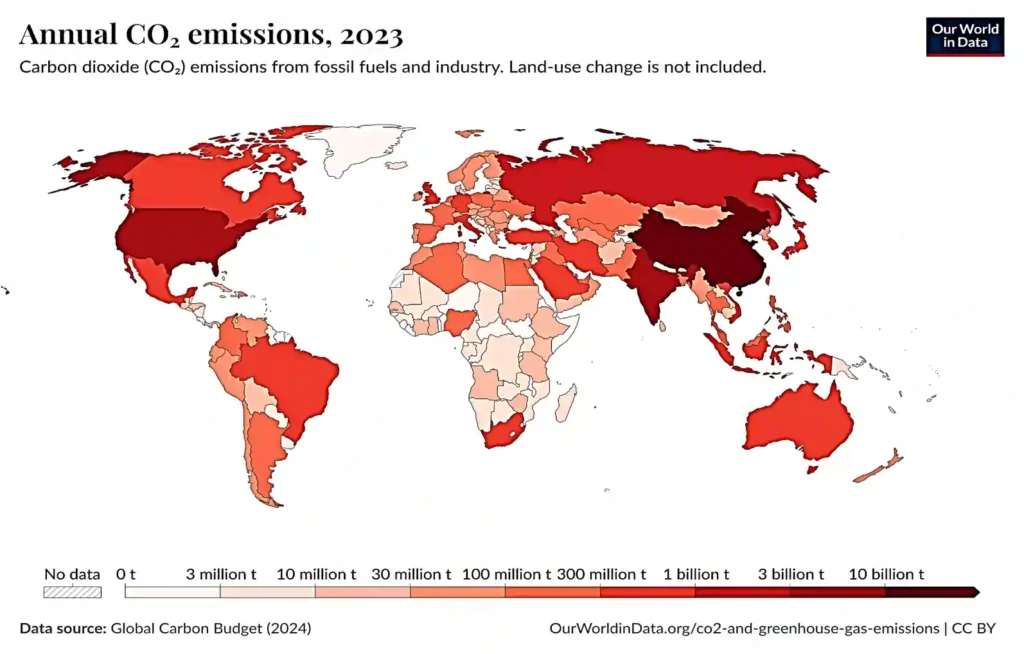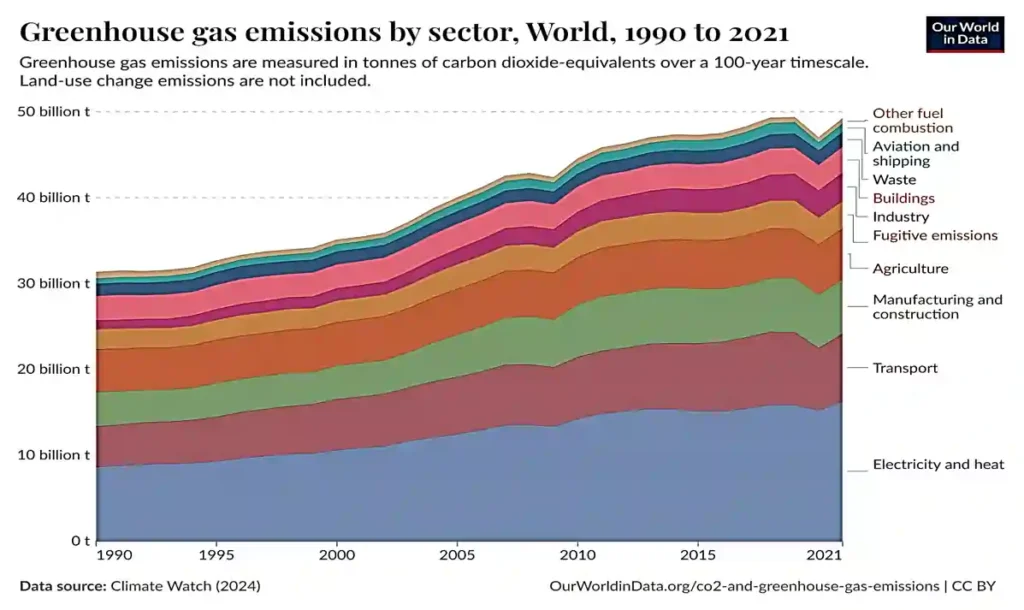Table of Contents
Everything we do—such as driving a car, using the internet, turning on lights, or throwing out trash—adds up and impacts the Earth, this impact is called our carbon footprint. It’s a way of measuring how much greenhouse gases, like CO2, which warm the planet, are produced by our daily activities.
As we know climate change is a significant problem, a personal carbon footprint calculator can help! It’s a simple tool that tracks CO2 emissions based on our daily routines. This tool tells how much we’re affecting the environment and provides suggestions for reducing our impact.
Personal Carbon Footprint Calculator
This Carbon Footprint calculator helps you to calculate how much carbon dioxide is added to the air from your daily life. You enter things like how much you drive, use electricity, eat meat, shop, stream videos, or travel.
It then calculates the total of these activities and displays your emissions in kilograms of CO2e per year, month, or day per person, allowing you to view your total in a chart. It also provides tips to reduce your impact, making it simple to understand how your choices affect the planet!
Note: Hover the mouse over the input field to fill in the correct input.
Also Read: The Crucial Role of Chemical Engineering in Everyday Life
Also Read: Online Psychrometric Calculator for Chemical Engineers
How to Calculate Carbon Footprint
A carbon footprint is the total amount of greenhouse gases (primarily carbon dioxide but also methane, nitrogen dioxide, and others) emitted directly or indirectly by our actions. It is usually measured in units of carbon dioxide equivalent (CO₂e).
The widely accepted method for the calculation of carbon footprint is given by Carbon Footprint (CO₂e) = Σ (Activity Data × Emission Factor)
- Activity Data is the measurable amount of an activity for example 100 miles driven, 500 kWh of electricity used.
- Emission Factor represents the GHG emissions per unit of activity for example 0.4 kg CO₂e per mile for a gas car, 0.2 kg CO₂e per kWh for grid electricity.
According to the global CO2 emissions data from fossil fuels reported by Our World in Data, the annual CO2 emissions worldwide from fossil fuels and industries amount to 37,791,570,000 tonnes of CO2 for year 2023.

As shown in the country data plotted, the top five contributors to annual CO2 emissions for the year 2023 are presented in the table below:
| Country/Area | Year – 2023 |
|---|---|
| China | 11,902,503,000.00 t |
| United States | 4,911,391,000.00 t |
| India | 3,062,324,500.00 t |
| Russia | 1,815,924,700.00 t |
| Japan | 988,784,700.00 t |
| Iran | 817,879,900.00 t |
Before the Industrial Revolution, CO2 emissions were low and grew slowly until the mid-20th century. In 1950, the world emitted 6 billion tonnes of CO2, which nearly quadrupled to over 20 billion tonnes by 1990.
Emissions have since risen rapidly to over 35 billion tonnes annually, though growth has recently slowed without reaching a peak.
Related : Visit our thermodynamic calculator for quick calculations
Related: Online Psychrometric Calculator for Chemical Engineers
How much is 1 tonne of CO2?
At standard temperature and pressure, 1 tonne (about 2,200 pounds) equals 557 cubic meters in volume, which you can imagine as a cube 8.2 meters on each side, similar to a small house or a large hot air balloon.
1 tonne, though a small part of global emissions, but it adds to nature’s imbalance by boosting the greenhouse effect, raising heat, warming the planet, disrupting weather patterns, melting ice caps and ocean acidification.
One tonne of CO2 is roughly equal to the CO2 from burning 370 liters (98 gallons) of gasoline, 0.43 tonnes of coal, or driving a car about 5,000 km.
One tonne of CO2 has about 272 kg (600 pounds) of carbon. Plants use it to grow. A mature tree absorbs 20-50 kg of CO2 per year, so it takes 20-50 years for one tree to capture 1 tonne.
Major Sources of Carbon Footprint
The carbon footprint shows how much CO2e we release into the air from our daily activities. It comes from many sources we use every day, like producing energy by burning coal, oil, and gas for electricity and heat.
Other activities also add to it, like driving cars, flying planes, and shipping goods for transportation. Heating or cooling our homes and buildings, plus the things we buy—like clothes, phones, and food—make the problem bigger too.

The main source of carbon footprint comes from energy, which includes electricity, heat, and transport, making up 73.2% of the total. Transport alone accounts for 16.2% of these emissions in year 2016.
After energy, other important sources include manufacturing and construction. Agriculture also adds to the carbon footprint. Together, these activities release a lot of greenhouse gases into the environment.
FAQs on Carbon FootPrint – CO2 Emissions
What is the formula for carbon footprint?
There’s no single formula, but it’s usually calculated as the total greenhouse gas emissions (like CO2) from your activities, measured in kilograms or tons of CO2 equivalent (CO2e).
How can I calculate my carbon footprint?
You can use our online calculators made by ChemEnggCalc by entering data like your energy use, travel habits, and food choices. It adds up emissions from those activities.
What is 1 kg of CO2 equivalent to?
1 kg of CO2 is like the emissions from driving a car about 4-5 kilometers (2.5-3 miles) or burning 0.5 liters (0.13 gallons) of gasoline.
What are the methods of carbon removal?
Planting trees, capturing CO2 from the air with machines (direct air capture), improving soil to store carbon, and using bioenergy with carbon capture.
Who is the biggest absorber of CO2
Oceans are the biggest natural absorbers of CO2, which takes about 25% of human-made emissions, followed by forests and soil.
Resources
Credits: U.S. EPA (epa.gov), IPCC (https://www.ipcc.ch/), BEIS (gov.uk), IEA (iea.org), and Poore & Nemecek (Science.org). Regional factors refine electricity emissions accuracy. Additional data from Our World in Data (ourworldindata.org).
Disclaimer: The content provided here is for educational purposes. While efforts ensure accuracy, results may not always reflect real-world scenarios. Verify results with other sources and consult professionals for critical applications. Contact us for any suggestions or corrections.






